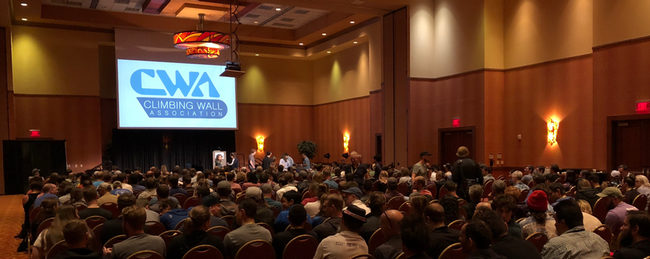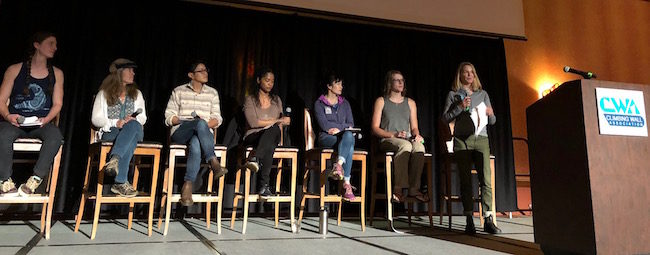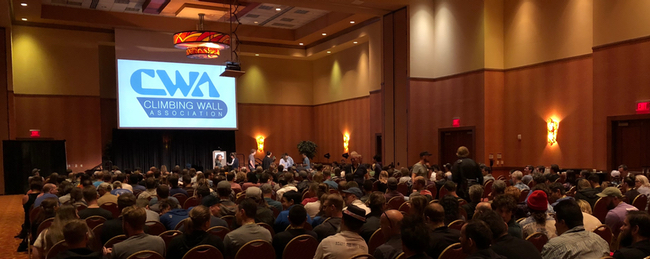
By John Burgman
Last week marked the Climbing Wall Association’s 12th annual summit, an all-encompassing event that has proven to be beneficial for gym owners and prospective developers, equipment manufacturers, professional climbers, thought leaders, and others associated with the various facets of indoor climbing.
While each year’s gathering features important discourse, the continual growth of the industry contributed to this year’s summit being the largest ever: Approximately 900 attendees converged at the Exhibit Hall of the Embassy Suites in Loveland, Colorado, from May 16-18, which was an increase of several hundred people compared to last year’s turnout.
The Climbing Wall Association (CWA) provided those in attendance with a record number of “breakout sessions” on topics that ranged from gym flooring and employee communication to finance and coaching. In fact, this year’s summit saw a 40 percent increase in the amount of such focus-group sessions. Complementing those smaller symposiums was a large showroom that featured display booths for clothing brands, hold shapers, and wall manufacturers from around the world. It all corresponded with the global popularity of gyms, as the summit included sponsors and attendees from Slovenia, Bulgaria, Singapore, Japan, and Canada, in addition to the United States.
“The industry is growing, so it’s important for the event to be aligned with that and to be emblematic of where the industry is at currently,” says Emily Moore, the Events Coordinator at CWA. “We’re always striving to ensure that [attendees] are happy from a logistical perspective, but the educational and professional development aspect of it is what keeps people coming back. So, it’s really critical that the presenters are genuine thought leaders on their topics and are hitting on subject matter that really resonates with their audience.”
In terms of educational and professional development, the 2018 summit was noteworthy for having multiple breakout sessions related to routesetting and the duties of staff routesetters. “There is a lot of opportunity to professionalize that role in the gym, and the content that we pulled together for this year was looking to address that, at least as a first step,” says Moore, who identifies routesetting as an area that will benefit from having more industry-wide resources going forward.
The summit included a presentation by Bouldering Project’s Tonde Katiyo titled, The Future of Routesetting, a presentation by Evo’s Nick Foster titled, The Cost of Setting, a panel moderated by Climbing magazine’s James Lucas titled, From Beginners to Crushers: A Discussion on Commercial & Competitions Routsetting, and a routsetting roundtable discussion moderated by Kilter’s Jackie Hueftle.

Laura Allured, the Marketing and Communications Manager at CWA, said, “The routesetting content this year was included intentionally because we see that as the industry grows and professionalizes, routesetting is also becoming more professionalized.” She adds, “We’re building a closer relationship to the routesetting community in order to better support their growth and professional development.”
Allured specifies that the CWA is planning to form a routesetting-based committee in the future that will create a commercial training program. CWA is also hoping to hold regional routesetting workshops and networking events, maintain an online forum for setters, and host a blog/newsletter for anyone interested in the craft.
FOCUSING ON CUSTOMERS, MANAGEMENT AND LEADERSHIP
This year’s summit was also significant for its increased focus on demographics related to climbing on the whole and, specifically, gym membership and participation. For example, the summit kicked off on Wednesday evening with a keynote speech by alpinist James Mills, author of The Adventure Gap and host of The Joy Trip Project podcast.
Mills’ speech explored the broad topic of diversity in the outdoors and advocated the creation of increased opportunities for minority communities to explore wilderness and climbing. “There are still a lot of strides to be made, in terms of who spends time in the outdoors and who doesn’t,” Mills said in his speech.
The demographics of the climbing industry were further discussed in breakout sessions. For example, a presentation led by Dr. Ryan Gagnon, climber and professor at Clemson University, was titled, Towards 5.16: Engaging Minority Groups in Climbing. Another breakout session moderated by Evo’s Hilary Harris was titled, Women in Climbing.
The culmination of the summit was a plenary panel—in front of a jam-packed audience—titled, Entrepreneurs, Athletes, Business Leaders: Women in Climbing. Moderated by Renee DeAngelis, COO of Planet Granite/Earth Treks, the panel included famed climber Lynn Hill, Stephanie Ko Pound of Planet Granite, Becca Droz of Movement, alpinist Sophia Dannenberg, Shelma Jun of Flash Foxy, and Halcy Webster of Alpenglow Collective.

Referencing the day’s previous roundtable discussion, Webster noted during the panel that there are a number of gyms that already have a healthy ratio of female to male members and gym participants. Webster added, “Also, in leadership, there’s a number of places that have female leadership from the top coming down, and this is really exciting to see those changes happen—even though it’s very regional, and some places don’t have it and some do. But that change is starting and also we can have that discussion here. This discussion wouldn’t have been a thing before, but now we have a room full of people wanting to hear about this, and that’s really awesome.”
One of the overarching messages of the panel, however, was that there are still many areas where the industry can improve in regards to equity and equality.
“The biggest thing that I’ve seen is when I go to the gym, the diversity that I see within the people who are climbing at the gym—I just don’t really see that when I go to a conference like this or Outdoor Retailer,” said Jun, addressing the summit audience from the stage. “I would really love to see some of the changes happening at an industry level. And—spoiler alert—it’s going to be harder. It’s harder to be intentional about hiring more women, more people of color, being inclusive, reaching out and mentoring to people who don’t have the same background as you. It’s more work. So, I want you to be prepared for that. It is going to be harder, but I just assure you that if we can do that, I really, truly believe it will make our communities so much richer.”
CASTING A WIDE NET
Amid the various presentations and panels over the course of the three days, products being unveiled in the showroom included the “world’s first friction adjustable fall reduction system” known as BelaySAFE from Singapore-based Climb Asia. Slovenia-based hold manufacturer Simpl also unveiled an interchangeable grip system for its volumes, which allows a routesetter to choose the degree of dual texture on a given hold. And Colorado-based Kilter set up its new training board for attendees to climb.
The challenge of any summit—both in the products showcased and the topics discussed—is to appeal to an audience that grows wider every year, says Moore. In additional to new gym owners and operators at all financial levels, last year’s merger of Planet Granite and Earth Treks means that the industry has begun to see high-level venture capitalism, which might continue with further mergers in the future. And the summit must appeal to those interests and backgrounds too.
She notes: “Some folks come as far out as, ‘I’m thinking about opening a climbing gym, but I’m not sure yet.’ And they have so many open-ended questions that [the summit] is an opportunity for them to learn what it takes to even make that dream possible. And then you get someone who says, ‘I’m building a gym this year, and I’m attending to figure out who my vendors are.’ And so you have these huge sales opportunities which parlays into sponsors and exhibitors.” She adds, “It gets complicated to try to address all those audiences. That’s where the presentations can really diversify.”
More information about the CWA can be found here.

John Burgman is the author of High Drama, a book that chronicles the history of American competition climbing. He is a Fulbright journalism grant recipient and a former magazine editor. He holds a master’s degree from New York University and bachelor’s degree from Miami University. In addition to writing, he coaches a youth bouldering team. Follow him on Twitter @John_Burgman and Instagram @jbclimbs. Read our interview Meet John Burgman, U.S. Comp Climbing’s Top Journalist.







